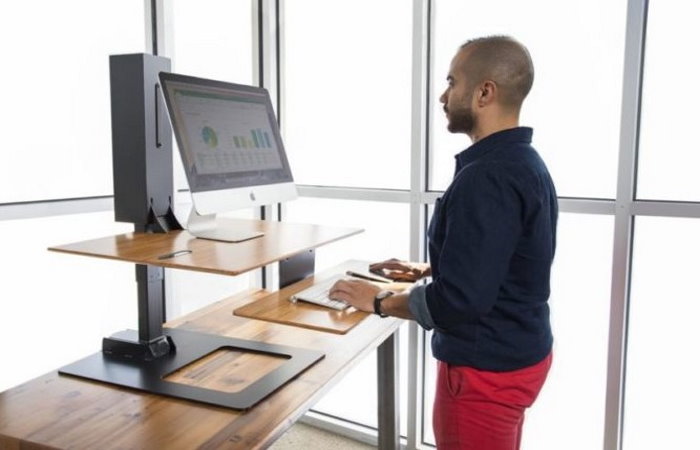Ergonomic Benefits of Standing Desks

It’s no secret that sitting for too long can cause significant health hazards, such as chronic neck and back pains that stretching can’t fix. So, what can you do about it? Standing desks are currently in the spotlight as a healthier alternative to traditional desks. Standing while working is the new norm in the modern workspace, but there is more to the ergonomics of standing desks that people don’t know. The lack of knowledge on the proper way to use standing desks deprives users of the ability to maximize its benefits.
Ergonomics of the Standing Desk
Standing desks are now a must-have as office furniture, especially for individuals looking to build an ergonomic workstation. This type of desk is the best way to beat inactivity at work while promoting productivity and well-being.
Why would you consider a standing desk? This study talks in-depth about the detrimental effects of office chairs on your long-term health. Mayo Clinic also published a report on how sitting is as dangerous to your health as smoking. All the evidence points to how using a standing desk can reverse the potentially harmful effects of sitting at work.
Sitting at work is just one of the many habits that modern folks have adopted in this day and age. Most people lead sedentary lives, and its impact can be seen in people’s health. The lack of physical movement is something to be taken seriously.
Standing desks are like traditional desks, except that you are standing and not sitting. They can significantly improve the amount of time spent standing without disrupting your workday routine.

Pros of Standing Desk
Here are some of the benefits that you can gain by switching to a standing desk:
- It keeps you mentally alert and focused. When you sit comfortably in your chair, you may feel sluggish, even sleepy. This feeling of sluggishness results from a lack of physical activity, which causes your energy level to drop. On the other hand, standing keeps you motivated and mentally alert while working.
- It promotes blood circulation and works your core muscle groups. Standing is known to cause your body to work harder (versus sitting), promoting blood flow and engaging several muscles.
- It burns more calories. While it is not the end-all solution to weight loss, any extra calories you burn while standing is a positive compared to sitting all day. According to a University of Chester study, you burn an additional 750 calories by standing for three hours for five days.
- It promotes good posture and spinal health. Hunching is a common position that many workers assume when they are sitting at work. This position can be detrimental to your spine over time. Standing corrects this position and ensures proper alignment of your spine, so you can avoid spinal injury.
Cons of Standing Desk
As mentioned earlier, standing desks can have their own set of drawbacks if not used correctly. These are some of the potential drawbacks you must know about:
- Standing at work can cause sore feet and tired knees. You need comfortable shoes with good support to keep your feet from being sore. It is also important to distribute your weight to both legs to avoid causing strain on your muscles and knees.
- Varicose veins could develop from standing for too long. The veins work harder when you stand for too long, causing them to swell and become visible on the surface of the skin.
- The studies on the benefits of standing at work are still in their infancy. More research must be done to suggest if it is really a healthier way to work. In the meantime, you can follow the correct way of standing to enjoy its ergonomic benefits.
Maximize the Ergonomics of a Standing Desk
There are several benefits to the ergonomics of standing desks. As mentioned above, they do come with their own set of pros and cons. The goal is to maximize the benefits and to minimize the negative effects of standing at your desk.
You can achieve this by knowing the proper way of using standing desks.

1. Proper posture is important.
Do not let your bad posture hinder the benefits that you can gain from using a standing desk. A common misconception among people that switch to this type of desk is to assume it automatically corrects their posture. It does not. Make an effort to keep your head, neck, torso, and legs in a straight vertical line.
If you can, add a footrest to your standing desk to allow you to shift your weight from one foot to the other. It is also important to invest in a pair of footwear with adequate support. The right footwear can minimize the impact on your feet when standing.
2. Keep your desk ergonomic.
A standing desk is just one aspect of an ergonomic workspace. The actual desktop is a crucial part of it and one that a lot of people often neglect.
Your desk must be deep enough so that your monitor is at least 20 inches away from you. A deep desk should also allow you to straighten your wrist and rest it on your desk. For this reason, you should avoid any rounded desks because they won’t give your wrist enough space to ease the pressure.
When organizing your work desk, consider the other essential items you need to work such as your keyboard and mouse. A deep desk is going to leave you enough room to rest your wrist with the keyboard and mouse so the space is not cramped.
3. Alternate Between Sitting and Standing
Knowing the potential drawbacks of standing for too long at work, you can switch from sitting and standing every few minutes. Some experts suggest a ratio of 2:1 for standing versus sitting as the ideal way to be productive while optimizing the health benefits of a standing desk. You can alternate between sitting and standing every 30 minutes to an hour.
A sit-stand desk is a good alternative for this routine. This will optimize your productivity and help maintain your energy level throughout the workday.






